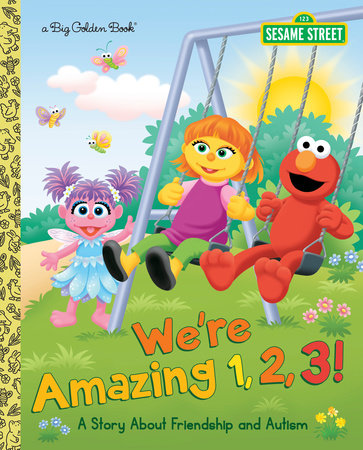Everyone Can Be a Friend: Getting to Know Julia, the Newest Friend on Sesame Street
by Leslie Kimmelman
How do you go about creating a character like Julia, the newest friend on Sesame Street? Well, at Sesame Workshop, it takes a village. It’s important to acknowledge that there were many other people involved in every step of Julia’s creation — art designers, puppet designers, advisors, educators, and so on — and of course, the book’s illustrator, Mary Beth Nelson.
For anyone writing about autism, the challenge is the same: The breadth of the autism spectrum is wide. For whom are you writing? What is possible to show effectively in a book? The Sesame Workshop initiative, “See Amazing in All Children”— which includes a dedicated website with parent and teacher materials, live-action film clips, animations, and more — addresses the totality of the spectrum. Both verbal and nonverbal children are represented, male and female, preschool and older, real kids with a variety of strengths and challenges. The book, We’re Amazing 1, 2, 3!, is just one part of the initiative. As for Julia? Well, she’s just one little 4-year-old. Clearly, she can’t be everything to everyone! She is simply “Sesame Street’s” representative of the millions of children with autism.
“Write what you know” is a common piece of writing advice, and that’s what I did. I am the mother of a now-grown son with autism, and Julia owes quite a lot to him: his love of music, certainly, and his generally joyful nature, as well as a few of his anxieties. Of course, as you might notice, Julia is a girl! To some people, that may seem counterintuitive: Far more boys are diagnosed with autism than girls. But that’s exactly what was behind the decision. Outside the autism community, many believe that ONLY boys are affected; it was important to break that stereotype. In addition, there’s a real lack of resources for families that speaks to girls. It seemed a gap we could fill. My hope, of course, is that Julia speaks to both genders equally.
I had several overall goals in writing the story: First and foremost, I wanted to show what a friendship might look like between Julia and her peers — in this case, some furry, googly-eyed peers whom kids already know and love. And to show that although they have differences, Julia and her friends also have much in common and many levels on which they can connect. Julia and Elmo have fun playing blocks together — albeit in different ways. They enjoy singing, swinging, and snacking at Hooper’s store. It turns out that having fun with friends is pretty universal! If young readers pick up on this one message — that everyone needs a friend, and that everyone can be a friend — well, that will be an extremely gratifying accomplishment.
Another primary goal was to model what might happen when a so-called neuro-typical child approaches a child with autism. An autistic child may not always know how to respond to overtures of friendship, and the initial lack of responsiveness can feel like rejection. I saw this firsthand as my son was growing up. Reaching out once was not enough. Only the most patient and persistent peers succeeded with him. In addition, some behaviors may be unfamiliar — hand-flapping, sensitivity to loud noises, or repetitive talking, for example. In We’re Amazing, 1, 2, 3!, I tried to show that everyone deals with the same emotions, though we may have different ways of expressing them. And that’s okay.
Good children’s books offer kids the chance to see themselves reflected on the pages, which is a powerful experience. Kids with autism rarely get this chance. Someone came up to me at a recent book-signing and told me that her daughter, after reading the book, said, “I’m a Julia.” It was exactly what I was hoping for. Good children’s books can also open the window to the larger world, helping kids see things outside their own daily lives. And I hope I’ve done that as well. Sooner or later, it’s likely that most people will know someone with autism.
The “See Amazing” initiative has dual messages: First, that people share more similarities than differences; and second, that the uniqueness of every child deserves to be celebrated. If we show young kids what autism looks like, they’ll accept it as just another part of the enormous range of human experience, rather than as something strange or scary. After all, we’re all different in some way or another. It’s our differences that make the world such a fascinating place. “Sesame Street” has always been a model of acceptance, the kind of neighborhood where all humans and monsters are welcome. There’s no better place for Julia to feel right at home.

